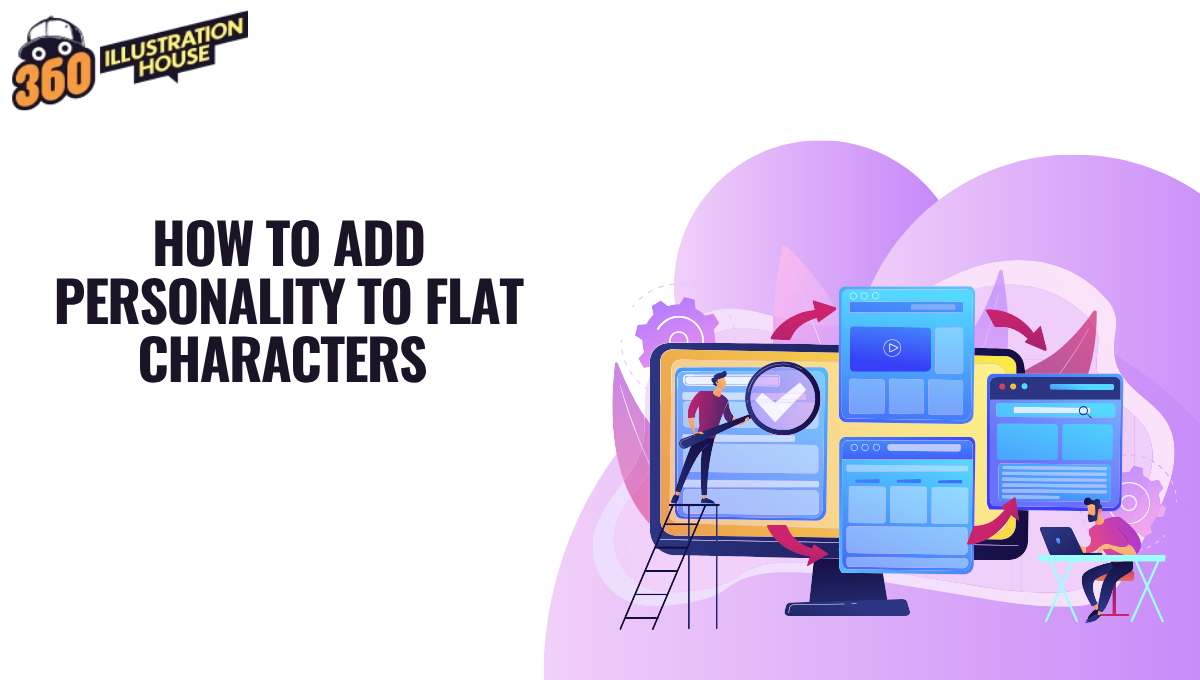How to Add Personality to Flat Characters
We all remember our favorite animated characters, the way they talk, walk, and laugh. Why? Because they have distinct traits...

We all remember our favorite animated characters, the way they talk, walk, and laugh. Why? Because they have distinct traits that make them more than just a drawing.
They feel real. That’s what makes them stick in our minds, even years later.
A flat character might look great on paper. But no one remembers, even the best-looking character, if they lack depth and expression. That’s why adding personality to your 2D characters is so important to connect with audiences.
In this post, we will explore simple ways to turn flat designs into memorable personalities. Let’s go in it.
Key Takeaways
- Make It Memorable With Depth: Start with a strong backstory and use personality archetypes to shape how they act and feel.
- Add Visual Storytelling: From facial expressions and body language to color palettes and clothing, each design choice should reflect your character’s personality.
- Include Small Quirks: A catchphrase, slouchy posture, or a nervous tic; these human touches make a flat character unforgettable.
What Makes a Character Feel Flat?
When your main character feels hollow, it’s time to learn why. Here’s what they could be missing:
- Lack of Emotional Depth and Motivation
Faces tell stories. If a character’s expression is stuck in neutral, it’s hard to connect.
- Lack of Light and Shadow to Create Form
Light brings life. Without contrast and highlights, your character lacks dimension and visual interest.
- Lack of Depth and Dimension
A flat character without shading looks like a simple sticker slapped on the screen.
Ways To Turn Your Flat Drawings into Unforgettable Characters
1. Start With a Strong Character Concept
Before you start sketching, pause and think: Who is this flat character?
Even if none of it shows up directly in your final artwork, it helps to create a backstory. Are they brave? Bitter? Are they running from something, or toward it?
Ask:
- What motivates them?
- What’s their biggest fear?
- Where do they belong?
- What role do they play — hero, villain, or sidekick?
This is the foundational step while working with 2D art development services. The clearer your concept, the better your collaborators can bring it to life.
2. Work on Expressive Facial Features & Body Language of Your Character
Your character’s face is the most immediate way to communicate personality. Even a simple smile, a raised eyebrow, or a subtle frown can tell a story.
According to Albert Mehrabian’s 7-38-55 communication model:
- 7% of emotions are conveyed through words
- 38% through tone
- 55% through the body language and facial expressions
This means your character’s facial expressions and body language carry more emotional weight than their dialogue. The face is where feelings are most clearly shown and understood.
Tips for Facial Expressions
Want your character to feel:
Curious? Widen the eyes, raise one brow slightly.
Angry? Drop the brows into a V and add tension to the jaw.
Confused? Tilt the head and lift one side of the mouth.
Tips for Body Language
Facial features are the emotional engine of your design. But don’t forget about the body. Body language says so much without words.
- Slouched shoulders? Probably timid, tired, or shy.
- Arms crossed? Could be sassy, closed off, or defensive.
- Bouncing on the heels with wide-open hands? Energetic and excited.
If you are hiring digital 2D art outsourcing services for your projects, clearly outline these visual cues to get more relevant results.
3. Choice of Design Elements That Reflect Personality
Beyond expressions and posture, design elements like shape, color, and clothing speak volumes about who your character is.
Clothing can tell if a character is neat, chaotic, confident, or insecure. A perfectly ironed outfit with polished shoes gives off a different vibe than a hoodie, pajama pants, and mismatched socks.
Accessories help too — a guitar case, a stack of books, a flashlight necklace. These little things hint at hobbies, history, or quirks.
Power of Shape
And don’t underestimate the power of shape.
Rounded forms = Friendly or innocent
Sharp Angles = Aggressive or dangerous
Asymmetry = Quirky, unpredictable, a little offbeat
Want to go the extra mile? Use visual metaphors. If your character’s hot-headed, maybe their clothing has flame patterns. If they’re mysterious, use shadowy tones and layered outfits.
Professional 2D illustration services often use these design principles deliberately to communicate personality through appearance. And so should you.
4. Create Distinctive Voice and Dialogue Cues
Even if your flat character doesn’t speak. Imagining their voice helps writers, animators, and illustrators maintain design consistency. Think, how would your character talk?
- Slang or formal speech?
- Quiet or over-the-top tone?
- Short, snappy dialogue or long-winded?
Personality traits strongly influence speech patterns, which in turn affect audience perception. Including dialogue style in your briefs helps custom 2D illustration services make flat characters feel 3D in 2D.
5. Use Repetition and Signature Quirks
The best flat characters have trademarks, like signature pose, sound, facial expression, or catchphrase.
Example
SpongeBob SquarePants is known for his infectious laugh and energy, consistent across episodes without overdoing it.
The key is balance—too much repetition can feel stale, but too little and the character may not stick in the audience’s mind.
6. Use Contrast to Make Them Shine
Your character is defined not just by themselves, but by who or what they are paired with or their environment.
A shy, quiet character might become more expressive when placed beside a loud, extroverted sidekick. The contrast between your character and their surroundings helps highlight their unique traits.
Try creating scenarios that show how your character reacts to:
- Praise
- Yelling
- Or when they are alone?
You’ll learn a lot about who they are just by imagining how they don’t fit.
7. Let Them Evolve
Flat characters often remain static, but their personality grows over time, even in 2D media.
Update in posture, color palette, or expression over time reflects growth and shifts in the story arc. This adds layers and keeps audiences invested.
Character evolution is a storytelling tool that reinforces personality and makes flat 2D characters feel alive rather than stuck.
And honestly? As you keep drawing them, they’ll probably evolve naturally. Let that happen. Let the personality unfold as you get to know them better.
Wrap Up
Here’s the truth: If you want your flat character to leap off the page and into someone’s memory, give them more than good looks. Give them personality.
It starts with a strong concept, moves through expressive facial and body cues, thoughtful design choices, and distinctive quirks. When combined with contrast and evolution, your flat characters transcend their simplicity and become memorable, relatable, and engaging.
Whether you’re sketching solo or partnering with a team that offers custom 2D art development services, remember that personality is what makes your character relatable, lovable, and unforgettable.
Frequently Asked Questions
- How much does it cost to create a 2D flat character?
Depending on detail, style complexity, style, and revisions, average rates range from $50 to $300+. Animation or vector work may cost more.
- What do you need from me to get started?
Most illustrators need character descriptions, moodboards, references, color preferences, and usage intent.
- Will the character be delivered in vector format or PNG?
Yes. Deliverables typically include high-res PNGs. Vector formats (SVG, AI, EPS) are available upon request.



